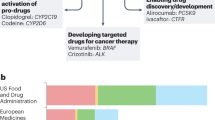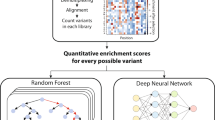Abstract
A key goal of pharmacogenetics — the use of genetic variation to elucidate inter-individual variation in drug treatment response — is to aid the development of predictive genetic tests that could maximize drug efficacy and minimize drug toxicity. The completion of the Human Genome Project and the associated HapMap Project, together with advances in technologies for investigating genetic variation, have greatly advanced the potential to develop such tests; however, many challenges remain. With the aim of helping to address some of these challenges, this article discusses the steps that are involved in the development of predictive tests for drug treatment response based on genetic variation, and factors that influence the development and performance of these tests.
This is a preview of subscription content, access via your institution
Access options
Subscribe to this journal
Receive 12 print issues and online access
$209.00 per year
only $17.42 per issue
Buy this article
- Purchase on Springer Link
- Instant access to full article PDF
Prices may be subject to local taxes which are calculated during checkout



Similar content being viewed by others
References
Lander, E. S. et al. Initial sequencing and analysis of the human genome. Nature 409, 860–921 (2001).
Venter, J. C. et al. The sequence of the human genome. Science 291, 1304–1351 (2001).
Altshuler, D. et al. A haplotype map of the human genome. Nature 437, 1299–1320 (2005).
Urban, T. J. et al. Functional genomics of membrane transporters in human populations. Genome Res. 16, 223–230 (2006).
Ross, J. S., Symmans, W. F., Pusztai, L. & Hortobagyi, G. N. Pharmacogenomics and clinical biomarkers in drug discovery and development. Am. J. Clin. Pathol. 124, S29–S41 (2005).
Jain, K. K. Challenges of drug discovery for personalized medicine. Curr. Opin. Mol. Ther. 8, 487–492 (2006).
Yates, C. R. et al. Molecular diagnosis of thiopurine S-methyltransferase deficiency: genetic basis for azathioprine and mercaptopurine intolerance. Ann. Intern. Med. 126, 608–614 (1997).
Relling, M. V. et al. Mercaptopurine therapy intolerance and heterozygosity at the thiopurine S-methyltransferase gene locus. J. Natl Cancer Inst. 91, 2001–2008 (1999).
Schaeffeler, E. et al. Comprehensive analysis of thiopurine S-methyltransferase phenotype–genetype correlation in a large population of German-Caucasians and identification of novel TPMT variants. Pharmacogenetics 14, 407–417 (2004).
Caraco, Y., Sheller, J. & Wood, A. J. Pharmacogenetic determination of the effects of codeine and prediction of drug interactions. J. Pharmacol. Exp. Ther. 278, 1165–1174 (1996).
Higashi, M. K. et al. Association between CYP2C9 genetic variants and anticoagulation-related outcomes during warfarin therapy. JAMA 287, 1690–1698 (2002).
Hawkins, G. A. et al. Sequence, haplotype and association analysis of ADRβ2 in multi-ethnic asthma case–control subjects. Am. J. Respir. Crit. Care Med. 174, 1101–1109 (2006).
Mallal, S. et al. for the PREDICT-1 Study Team. HLA-B*5701 screening for hypersensitivity to abacavir. N. Engl. J. Med. 358, 568–579 (2008).
Furuta, T. et al. Influence of CYP2C19 pharmacogenetic polymorphism on proton pump inhibitor-based therapies. Drug Metab. Pharmacokinet. 20, 153–167 (2005).
Desta, Z., Zhao, X., Shin, J. G. & Flockhart, D. A. Clinical significance of the cytochrome P450 2C19 genetic polymorphism. Clin. Pharmacokinet. 41, 913–958 (2002).
Rieder, M. J. et al. Effect of VKORC1 haplotypes on transcriptional regulation and warfarin dose. N. Engl. J. Med. 352, 2285–2293 (2005).
Relling, M. V., Pui, C. H., Cheng, C. & Evans, W. E. Thiopurine methyltransferase in acute lymphoblastic leukemia. Blood 107, 843–844 (2006).
Marsh, S. & McLeod, H. L. Cancer pharmacogenetics. Br. J. Cancer 90, 8–11 (2004).
Rae, J. M. et al. Genotyping for polymorphic drug metabolizing enzymes from paraffin-embedded and immunohistochemically stained tumor samples. Pharmacogenetics 13, 501–507 (2003).
Marsh, S., Mallon, M. A., Goodfellow, P. & McLeod, H. L. Concordance of pharmacogenetic markers in germline and colorectal tumor DNA. Pharmacogenomics 6, 873–877 (2005).
Cheng, Q. et al. Karyotypic abnormalities create discordance of germline genotype and cancer cell phenotypes. Nature Genet. 37, 878–882 (2005).
McLeod, H. L. & Marsh, S. Pharmacogenetics goes 3D. Nature Genet. 37, 794–795 (2005).
Hauser, I. A. et al. ABCB1 genotype of the donor but not of the recipient is a major risk factor for cyclosporine-related nephrotoxicity after renal transplantation. J. Am. Soc. Nephrol. 16, 1501–1511 (2005).
Jin, Y. et al. CYP2D6 genotype, antidepressant use, and tamoxifen metabolism during adjuvant breast cancer treatment. J. Natl Cancer Inst. 97, 30–39 (2005).
Custodio das Dores, S. M. et al. Relationship between diet and anticoagulant response to warfarin: a factor analysis. Eur. J. Nutr. 46, 147–154 (2007).
Evans, B. J. & Flockhart, F. D. The unfinished business of US drug regulation. Food Drug Law J. 61, 45–64 (2006).
Lesko, L. J. et al. Pharmacogenetics and pharmacogenomics in drug development and regulatory decision making: report of the first FDA–PWG–PhRMA–DruSafe Workshop. J. Clin. Pharmacol. 43, 342–358 (2003).
Reis-Filho, J. S., Westbury, C. & Pierga, J. Y. The impact of expression profiling on prognostic and predictive testing in breast cancer. J. Clin. Pathol. 59, 225–231 (2006).
Fan, C. et al. Concordance among gene-expression-based predictors for breast cancer. N. Engl. J. Med. 355, 560–569 (2006).
Sebastiani, P., Ramoni, M. F., Nolan, V., Baldwin, C. T. & Steinberg, M. H. Genetic dissection and prognostic modeling of overt stroke in sickle cell anemia. Nature Genet. 37, 435–440 (2005).
Sackett, D. L,. Hayes, R. B,. Guyatt, G. H. & Tugwell, P. Clinical Epidemiology 2nd Edn (Little Brown, Boston, Massachusetts, 1991).
Tantisira K. G. et al. Corticosteroid pharmacogenetics: association of sequence variants in CRHR1 with improved lung function in asthmatics treated with inhaled corticosteroids. Hum. Mol. Genet. 13, 1353–1359 (2004).
Acknowledgements
We would like to thank Richard M. Weinshilboum, MD and the White Paper subcommittee of the PGRN network for valuable suggestions. Financial support is also acknowledged: U01 HL065899 (S.T.W.); U01 GM63340 (H.L.M.); UO1 GM061373 (D.A.F.); DA 20830 (N.L.B.); U01 GM074492 (J.A.J.); GM61393 (M.J.R. and M.E.D.); and GM61390 (K.M.G.).
Author information
Authors and Affiliations
Corresponding author
Related links
Related links
DATABASES
OMIM
FURTHER INFORMATION
Glossary
- Environmental phenocopy
-
A clinical case of a complex trait due solely to environmental factors.
- Epistasis
-
The interaction or interdependence of two or more genes.
- Incomplete penetrance
-
Occurs when less than 100% of a population with an identical mutant genotype display the associated phenotype.
- Linkage disequilibrium
-
The nonrandom association of alleles in the genome.
- Mode of inheritance
-
Dominant mode of inheritance occurs when only one copy of the allele is necessary to produce the phenotype. Recessive mode of inheritance occurs when both copies of the allele are necessary to produce the phenotype.
- Pleiotropy
-
A single mutation that has more than one biological effect or phenotype.
- Receiver operating characteristic (ROC) curve
-
A curve that plots I-sensitivity on the y axis and specificity on the x axis. The area under this curve is a measure of test performance.
- Severe adverse event
-
An event that occurs less than 1 in 10,000 administrations of the medication and is life threatening.
Rights and permissions
About this article
Cite this article
Weiss, S., McLeod, H., Flockhart, D. et al. Creating and evaluating genetic tests predictive of drug response. Nat Rev Drug Discov 7, 568–574 (2008). https://doi.org/10.1038/nrd2520
Published:
Issue Date:
DOI: https://doi.org/10.1038/nrd2520
This article is cited by
-
Pharmacogenomics of Antipsychotic Drugs
Current Treatment Options in Psychiatry (2017)
-
The Nuremberg Code subverts human health and safety by requiring animal modeling
BMC Medical Ethics (2012)
-
The institutional review board is an impediment to human research: the result is more animal-based research
Philosophy, Ethics, and Humanities in Medicine (2011)
-
Are animal models predictive for humans?
Philosophy, Ethics, and Humanities in Medicine (2009)
-
IL28B is associated with response to chronic hepatitis C interferon-α and ribavirin therapy
Nature Genetics (2009)



